The ASUS ZenFone 2 Review
by Brandon Chester on May 26, 2015 8:00 AM ESTBattery Life
For many years the limited battery life of smartphones has been the most painful part of their experience. It's never fun to have your smartphone die during the middle of the day, and many users long for the days where their flip phone could last for days or even weeks on a single charge.
Although the battery life of smartphones is still a long way off from the simpler mobile phones of the past, it has improved significantly over devices like the original iPhone which were the first generation of what could be called modern smartphones. Improvements in software optimization and the power consumption of components has improved battery life, and the increasing size of devices has allowed for larger batteries to be used. However, that isn't to say that the battery life of a device can be determined solely by its battery capacity. The total power draw of all the components in a smartphone can vary dramatically from device to device. A great example is the Nexus 6 and the Galaxy Note 4, which have nearly identical specifications on paper but completely different battery life.
While many battery tests often standardize at some percentage on the Android brightness slider such as 50%, that percentage can correspond to various different luminance values. To ensure that the true brightness of each device is equal, all devices are calibrated to a brightness of 200 nits. As usual, we begin with our web browsing battery tests which are more display bound than our fixed CPU and GPU load tests. This test loads web pages on a fixed interval, which gives both the SoC and modem a period of idle time between each page load. This ensures that the test does not penalize certain SoCs for being faster by causing them to do more work.
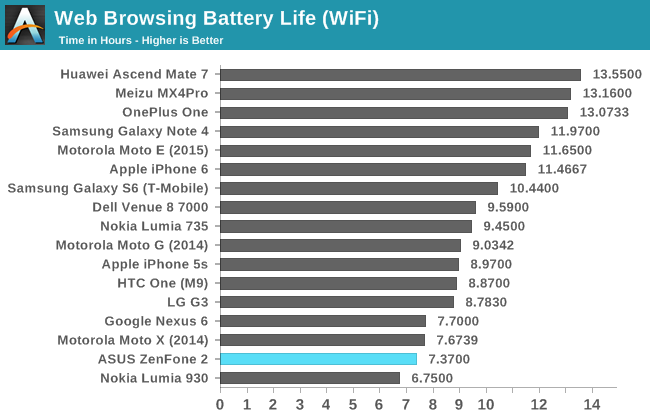
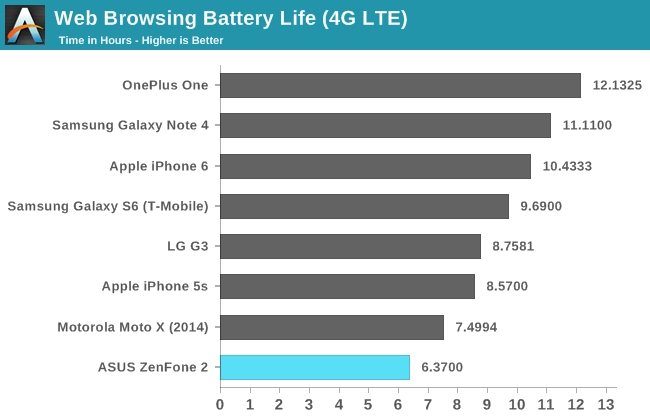
After rounding off a few seconds, the ZenFone 2 gets 7.37 hours in our WiFi web browsing test, and drops by an hour to 6.37 hours when using LTE on band 4. Both of these results are lower than one would expect from the ZenFone 2's fairly large 11.4Wh battery. However, I think there's a reasonable explanation for the results, and it also answers some questions that may have arisen after reading the previous page.
I had two big questions after testing the ZenFone 2's display. The first was "Why does ASUS employ the use of such heavy CABC and dynamic contrast?" The second was "Why does ASUS limit the maximum brightness to around 80% of what the display is capable of?" I think these battery results answer both of them, and ASUS provided some additional information that supports it as well. The display and LED backlight on the ZenFone 2 is likely not as efficient as those on some other smartphones. In our web browsing test the display is by far the largest consumer of power, and yet the OnePlus One with the same display size and resolution achieves a 77% longer run time with only 3% more battery capacity. Even with differences in SoC power usage, the only component such a large gap can be attributed to is the display.
In addition to the likely issues with display power usage, the ZenFone 2 also does not support Panel Self Refresh (PSR), which means that there's additional SoC and display bus power usage compared to smartphones that do support PSR. All of these factors lead to what is ultimately an underwhelming result for a 5.5" device with an 11.4Wh battery. The notable gap between the results on LTE and WiFi also would suggest that XMM7262 isn't quite at the level of Qualcomm's most recent parts when it comes to RF system power, but we would need to do a lot more investigation to draw any solid conclusions.
Our next battery test is PCMark's battery tests. PCMark's battery test is actually one of my favorite battery benchmarks because it mixes together various different tasks, stresses different parts of the hardware, and in general gives a very good idea of how battery life will be when the user is doing many things with their smartphone.
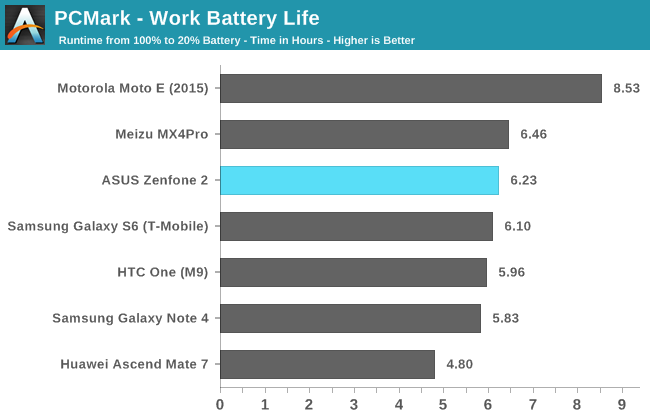
In PCMark's battery life test we see that the ZenFone 2 actually lasts slightly longer than some of our recent flagship devices. This is a favorable result for ASUS, because it shows that in scenarios with mixed usage and varying display APLs the ZenFone 2 doesn't fall behind the competition in addition to sustaining high performance from run to run. However, it should be noted that in those lower APL scenarios the ZenFone 2 is dropping below 200nits of brightness for white in order to reduce display power, which means that the display is actually dimmer than the competition to achieve the same level of battery life in this test. PCMark's temperature monitoring in their graph doesn't seem to have worked on the ZenFone 2. While Canada can get pretty cold, it's not currently that cold.
While our web browsing test is mostly display-bound, and PCMark is a more balanced workload, the next two battery tests tend to be SoC-bound. These tests tend to reveal which OEMs handle thermal throttling more gracefully than others. The first test is GFXBench 3.0's battery test, which puts a strong stress on a device's GPU, similar to playing a visually intensive 3D game.
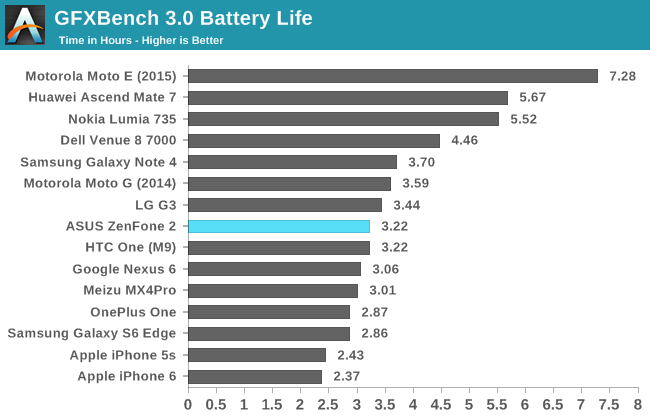

There are two sides of the story with the GFXBench battery test. While it's good to achieve a long battery life, it's not very useful if your frame rate during the test would have made for an unplayable game in the situation where the user is actually playing a game instead of running a benchmark. Devices like the iPhone 6 don't last as long as other devices, but show essentially no GPU throttling and retain a high frame rate even by the last run of the test.
In the case of the ZenFone 2, we see that it lasts exactly as long as the HTC One (M9). Last run GPU performance is noticeably slower though. Overall I would say the ZenFone 2's performance in this test is fairly good. Its battery life is in range of devices like the LG G3 and the Nexus 6, but it has higher sustained performance than either of them. ASUS and Intel also handle thermal throttling very well, with the frame rate dropping down from around 30 to 22 over the course of the first 20 minutes, and remaining there for the remaining two hours of the test.
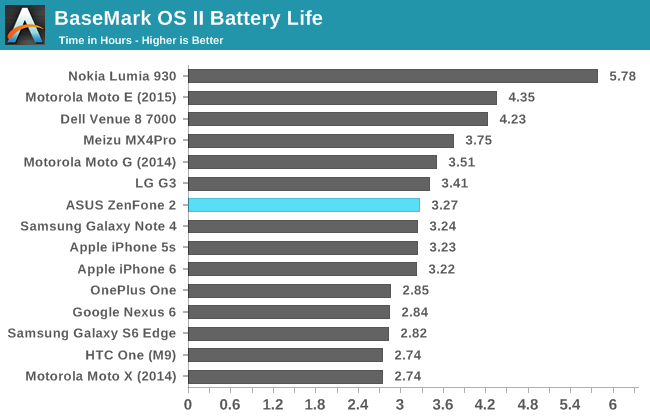
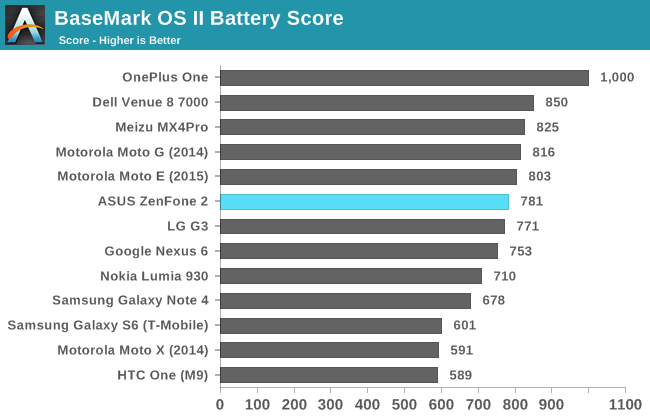
Our final test is BaseMark OS II's battery life test. This test puts a sustained load on the CPU, and the battery score is calculated based on the average amount of battery percentage consumed for each minute the test runs, as well as the level of CPU usage during the duration of the test. In both results we see that the ZenFone 2 does well for a device with its speed. Both the battery life result and battery score result are very close to those of the LG G3.
Overall the battery situation on the ZenFone 2 is somewhat mixed. Web browsing is definitely the heaviest scenario for power usage due to the display, but the ZenFone 2 is able to last fairly long in more mixed workloads. The downside that isn't reflected in these results is that the ZenFone 2 is lowering its brightness during tests that have lower display APLs, which means that while it may last as long as a competing device, if you were actually doing those tasks yourself you would be dealing with a dimmer display than the competition. Ultimately I think ASUS's solution of display dimming is the best option they could have chosen, as the alternative is basically to just have short battery life in every circumstance.
Charge Time
Something that is becoming a common feature for modern smartphones is the ability to charge at a rate faster than the standard 5V 1A spec that devices and charging blocks used in the past. The most well known standards for achieving this are Qualcomm's Quick Charge and Quick Charge 2.0.specifications. Fast charging is essentially a trade off between battery longevity and charge times, and it really relies on the assumption that smartphones are replaced every two years which is less time than any user would notice possible adverse effects. This rapid replacement of devices is somewhat worrisome, but that's a topic for another time.
The $199 model of the ZenFone 2 ships with a standard charging block, while the $299 model ships with ASUS's 18W BoostMaster charger. While ASUS is marketing their charger using their own branding, I have confirmed myself that the ZenFone 2 also supports fast charging using Qualcomm QC 2.0 certified charging blocks, such as the one that shipped with the Nexus 6. This is good news for anyone who buys the $199 model and can't get ASUS's charging block separately.

ASUS's 18W charger supplies power at 9 volts and 2 amps. This is the fastest charging block I have in my possession, and it charges the ZenFone 2 extremely quickly. While it's still beaten by the S6 Edge, the gap is very small, and the ZenFone 2's battery is around 27% larger. While battery life on the ZenFone 2 may not always be the best, buyers may find some comfort in knowing that when it does die they'll be able to get it up and running in a very short period of time.


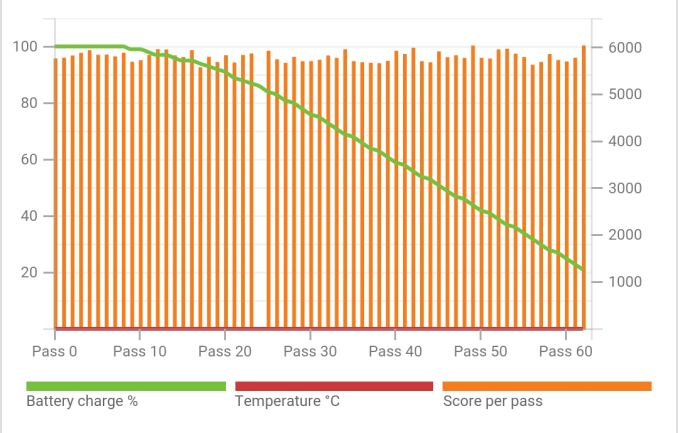
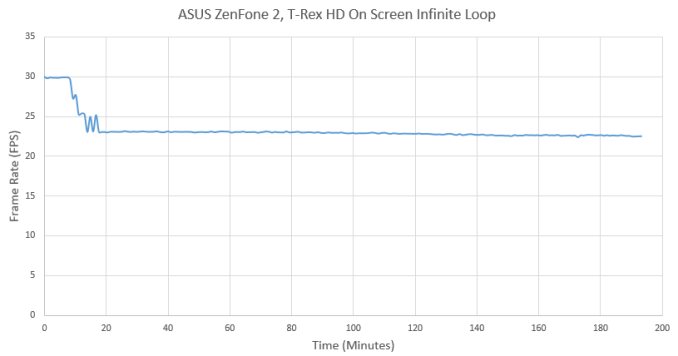








147 Comments
View All Comments
jt122333221 - Tuesday, May 26, 2015 - link
Heads up - it also supports double-tap to sleep. Unfortunately, you have to double-tap on a completely empty portion of the display (empty homescreen or in the notification bar) to get it to sleep.mkozakewich - Tuesday, May 26, 2015 - link
Put Cherry Trail in here with Window 8 (and then 10) and it would totally be what I'm looking for in a phone. I'm going to have to keep my eyes open.commenter001 - Tuesday, May 26, 2015 - link
I just bought the 4GB model. I've actually been using it more than my S6! What the review kinda skipped on was real world usage of the device. This thing doesn't skip a beat. It's amazing how many apps you re-open and they're right back where you left them (hours ago). Unlike the S6 where it seems to reload every dang time just after normal usage. The power button is not a big deal, I use the double-tap on the screen to wake it up all the time.The battery life is not that horrible, gets me through the day and I'm in poor cell area most of the time. Video and pictures, yeah, they're pretty average.
Again, I'm amazed at the lack of the usual lagginess that I've come to accept from Android. Maybe it'll creep up over time but so far this phone is on par or exceeds the S6 just in real world day-to-day stuff for me.
ketacdx - Thursday, May 28, 2015 - link
I agree man, this thing is surreal for real world usage. Battery really is pretty decent, mine is about 2% right now with 24 hrs on, 3hrs49mins of which are screen on time. Only thing I notice with mine is Android OS is using 31% of battery with CPU total at 10hrs 16 mins. I can only assume a glitch or Android issue that hopefully repairs with updates. Either way, pretty decent!! :)blzd - Thursday, May 28, 2015 - link
I'd say that's less of an accomplishment from Asus and more of a standard failing from Samsung and Touchwiz.Have you tried any other recent Android devices? Nexus devices and Motorola using stock Android have felt just as snappy and fluid for years now and it's only gotten better with Lollipop.
hans_ober - Tuesday, May 26, 2015 - link
How would this compare to the Xiaomi Mi 4i? In India, the lowest model of the Zenfone 2 is price competitive with the Xiaomi Mi 4i, which I hope AT manage to get their hands on.aryonoco - Wednesday, May 27, 2015 - link
Great article. Thanks to your work Brandon, I'm beginning to not even miss Brian any moreThis was a pleasure to read. Thank you.
lvchubby - Wednesday, May 27, 2015 - link
I'm a newcomer and respect Anandtech's true reviews instead of some others which look like marketing articles, but there's something missing about this review. I agree that the device is very value for money, but there are also quite a large number of complaints on Taiwan's user forums (in Chinese of coz) about QC and compatibility issues every time Asus launch a new phone in Taiwan. Sadly it happens repeatedly and Zenfone2 is not an exception, and still many people bought it due to it's CP value. Some of them were blaming Asus for using them as beta testers before the international launch. That's why I'm still holding up my decision.I'm not saying the Zenfone2 is not a good device, but for those who wanna buy it, I'd suggest holding up your decision for a few months till Asus hopefully solving most of the compatibility issues by software updates. Also check carefully for any faults when u receive the device.
As a side note, there are some local reviews/users saying the 3Gb RAM is not quite enough as the Zen UI eats up much RAM, and 4Gb RAM version is recommended.
chrnochime - Wednesday, May 27, 2015 - link
You mean like this thread from mobile01(yeah I read Chinese too):w w w . mobile01 . com/topicdetail.php?f=588&t=4395771
Hopefully this will force them get their shit together since they're now selling in the US...
lvchubby - Wednesday, May 27, 2015 - link
U can find similar posts even in Asus' own forum:http://w w w . asus . com/zentalk/tw/forum.php?mod=forumdisplay&fid=174
And imo it's a shame that the CEO admitted the beta tester thing...
http://w w w . mobile01 . com/topicdetail.php?f=588&t=4332578